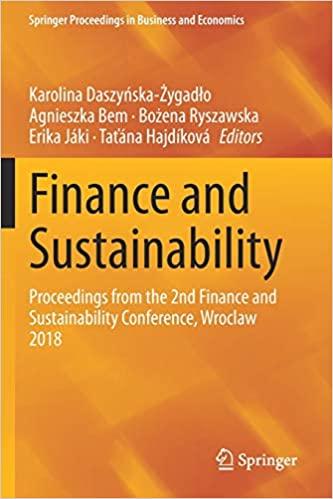Question
3. Yield to Call, Yield to Maturity, and Market Rates Absalom Motors's 15% coupon rate, semiannual payment, $1,000 par value bonds that mature in 20
3. Yield to Call, Yield to Maturity, and Market Rates
Absalom Motors's 15% coupon rate, semiannual payment, $1,000 par value bonds that mature in 20 years are callable 4 years from now at a price of $1,050. The bonds sell at a price of $1,205.42, and the yield curve is flat. Assuming that interest rates in the economy are expected to remain at their current level, what is the best estimate of the nominal interest rate on new bonds? Round your answer to two decimal places.
________ %
4. A bond trader purchased each of the following bonds at a yield to maturity of 8%. Immediately after she purchased the bonds, interest rates fell to 6%. What is the percentage change in the price of each bond after the decline in interest rates? Fill in the following table. Round your answers to two decimal places.
| Price @ 8% | Price @ 6% | Percentage Change | |
| 10-year, 10% annual coupon | $ ________ | $ ________ | ________ % |
| 10-year zero | ________ | ________ | ________ % |
| 5-year zero | ________ | ________ | ________ % |
| 30-year zero | ________ | ________ | ________ % |
| $100 perpetuity | ________ | ________ | ________ % |
5. Bond Value as Maturity Approaches
An investor has two bonds in his portfolio. Each bond matures in 4 years, has a face value of $1,000, and has a yield to maturity equal to 8.5%. One bond, Bond C, pays an annual coupon of 10.5%; the other bond, Bond Z, is a zero coupon bond. Assuming that the yield to maturity of each bond remains at 8.5% over the next 4 years, what will be the price of each of the bonds at the following time periods? Assume time 0 is today. Fill in the following table. Round your answers to the nearest cent.
| t | Price of Bond C | Price of Bond Z |
| 0 | $ ________ | $ ________ |
| 1 | ________ | ________ |
| 2 | ________ | ________ |
| 3 | ________ | ________ |
| 4 | ________ | ________ |
6. Yield to Maturity and Yield to Call
Arnot International's bonds have a current market price of $1,250. The bonds have an 11% annual coupon payment, a $1,000 face value, and 10 years left until maturity. The bonds may be called in 5 years at 109% of face value (Call price = $1,090).
A. What is the yield to maturity? Round your answer to two decimal places. ________ %
B. What is the yield to call, if they are called in 5 years? Round your answer to two decimal places. ________ %
C. Which yield might investors expect to earn on these bonds, and why? _________________
I. Investors would not expect the bonds to be called and to earn the YTM because the YTM is greater than the YTC. II. Investors would not expect the bonds to be called and to earn the YTM because the YTM is less than the YTC. III. Investors would expect the bonds to be called and to earn the YTC because the YTC is less than the YTM. IV. Investors would expect the bonds to be called and to earn the YTC because the YTM is less than the YTC.
D. The bond's indenture indicates that the call provision gives the firm the right to call them at the end of each year beginning in Year 5. In Year 5, they may be called at 109% of face value, but in each of the next 4 years the call percentage will decline by 1 percentage point. Thus, in Year 6 they may be called at 108% of face value, in Year 7 they may be called at 107% of face value, and so on. If the yield curve is horizontal and interest rates remain at their current level, when is the latest that investors might expect the firm to call the bonds? _________________
Step by Step Solution
There are 3 Steps involved in it
Step: 1

Get Instant Access to Expert-Tailored Solutions
See step-by-step solutions with expert insights and AI powered tools for academic success
Step: 2

Step: 3

Ace Your Homework with AI
Get the answers you need in no time with our AI-driven, step-by-step assistance
Get Started


